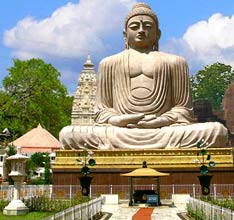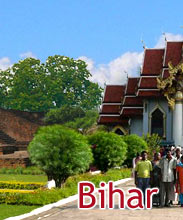 Contrary to general belief the existing Bodhi Tree is not the original Bodhi Tree under which Sidhartha Gautam had enlightenment. The existing tree is of fifth generation of original Bodhi Tree. The tree located south of the Mahabodhi Temple has great relevance for Buddhists, for simple reason that under this tree only Sidhartha had enlightenment. The tree is 80 feet high and about 115 years old. Also, there is a stone platform on which the Buddha is supposed to have sat in meditation gazing east, under the Bodhi tree.
Contrary to general belief the existing Bodhi Tree is not the original Bodhi Tree under which Sidhartha Gautam had enlightenment. The existing tree is of fifth generation of original Bodhi Tree. The tree located south of the Mahabodhi Temple has great relevance for Buddhists, for simple reason that under this tree only Sidhartha had enlightenment. The tree is 80 feet high and about 115 years old. Also, there is a stone platform on which the Buddha is supposed to have sat in meditation gazing east, under the Bodhi tree.The myth behind the uprooted original Bodhi tree according to belief is that that the Emperor Ashoka's wife destroyed the actual tree out of jealousy since he devoted too much time on the The Bodhi Tree. Later on, another Bodhi Tree was planted at the very spot by using its sapling taken from Sri Lanka. Historical records say that Sanghmitra, the daughter of king Ashok took one branch of Bodhi Tree to Anuradhapur and planted it which still exists at Anuradhapur.
Kalingabodhi Jataka, a Buddhist source gives a vivid description of the tree and the surrounding area prior to the Enlightenment, and the 'Asokavadana', which relates the story of King Asoka's conversion to Buddhism. His subsequent worship under the sacred tree apparently angered his queen to the point where she ordered the tree to be felled. Ashoka then piled up earth around the stump and poured milk on its roots. The tree miraculously revived and grew to a height of 37 meters. He then surrounded the tree with a stone wall some three meters high for its protection.
The Bodhi Tree at Anuradhapur too has same sacredness as Bodhi Tree at Bodh Gaya has. The Bodhi Tree at Anuradhapur today is called ‘Sri Maha Bodhi’ in Sri Lanka. The tree planted in 288 BC which also is the oldest verified specimen of any angiosperm. The tree is very significant and sacred to all Buddhists and majority of these trees in monasteries and Buddhist homes are descendants of the Bodhi tree. The Bodhi Tree was often used as an image of Lord Buddha during in early Buddhist art.











